#naturalsciencesbrussels
Text
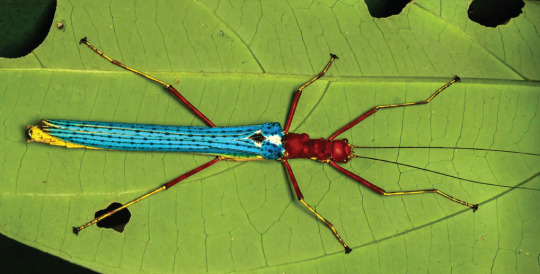



A bright blue stick insect! Stick insects are masters of camouflage, right? Well, our biologists just described a new species that didn't read the manual! #NatureIsTheGreatestShow
Why the wings are so blue and in-your-face remains a mystery for now. Possibly it signals to predators "I'm not tasty!". Indeed, these stick insects secrete a repellent substance.
It is even more fascinating: there are two types of females within this species Calvisia khlongsokana. One with blue wings and one with pale wings. This is not unusual in nature: two different types could increase the chances of survival when conditions suddenly change.
Together with colleagues our taxonomist Jérôme Constant and 'citizen scientist' Joachim Bresseel described this blue stick insect from Thailand and Myanmar. They regularly travel to Southeast Asia to find new species. It's an insect heaven that slowly reveals its secrets.
[Watch the mini documentary we made about their work]
#nature is the greatest show#naturalsciencesbrussels#insects#stick insects#entomology#taxonomy#thailand#myanmar#royal belgian institute of natural sciences
430 notes
·
View notes
Photo

https://www.instagram.com/p/CUs3VFaI4kV/?utm_medium=tumblr
#naturalsciencesbrussels#museum#fineartphotography#artphotography#vincentmourlonb#brussels#belgium#contemporaryphotography
5 notes
·
View notes
Photo

Nope, this is not a fossilised plant! Look closely, and you notice the head and the tail fin of a prehistoric #fish. The tree-like marks are not part of the fossil, but inorganic features called dendrites. These beautiful marks, similar to #snowflake formation, form when #mineral solutions penetrate the cracks in the stone. In this case, the mineral is manganese oxide. This fossil, ascribed to the prehistoric fish species Tharsis dubius, comes from the #Solnhofen limestone in the state of #Bavaria, between #Nuremberg and #Munich. In addition to the world famous Archaeopteryx fossil, it is also known for spectacular dendrite formations like this one. #fossilfriday #fossil #fish #naturalsciencesbrussels #science #nature #brussels #germany #crystals #minerals
#nuremberg#bavaria#mineral#naturalsciencesbrussels#nature#science#fish#munich#minerals#fossilfriday#germany#fossil#crystals#brussels#snowflake#solnhofen
0 notes
Text
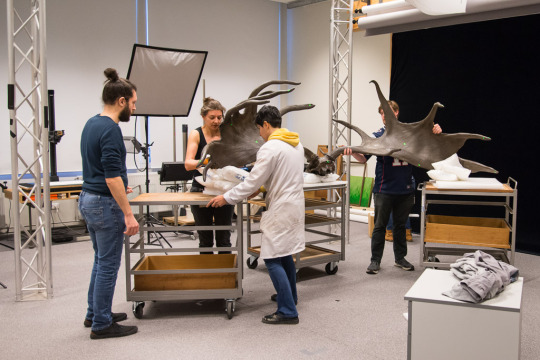
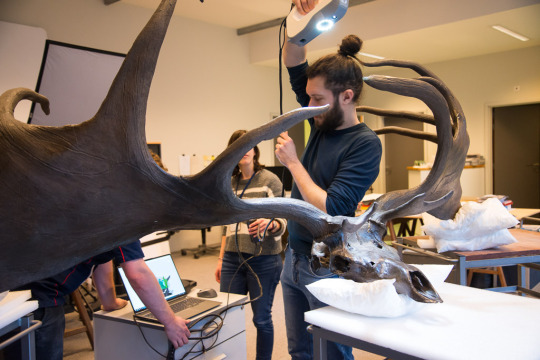



We've scanned the skull and the incredibly big antlers of Megaloceros giganteus or Irish elk! Quite a challenge, as you can see, but the result was there: a 3D version with all the details of the antlers of one of the largest cervids ever!
Irish elk lived during the same period as woolly mammoth and went extinct about 7,650 years ago.
#naturalsciencesbrussels#megaloceros#irish elk#behind the scenes#collections#natural history collections#scanning
144 notes
·
View notes
Text
youtube
COLOSSAL ANCIENT WHALE COULD BE THE HEAVIEST ANIMAL EVER!
Perucetus colossus, an ancient whale that swam off the coast of present-day Peru 39 million years ago, rivals the blue whale as the heaviest animal ever. A blue whale can weigh up to 100-190 tonnes, but the newly described extinct marine mammal weighed between 85 and 340 tonnes, estimate palaeontologists in a study published in the journal Nature.
‘The discovery pushes extreme growth in whales to a much earlier phase in their evolution than previously thought’, says paleontologist and co-author Olivier Lambert from the Royal Belgian Institute of Natural Sciences.
Read more on our website: www.naturalsciences.be
35 notes
·
View notes
Text





They look like Christmas tree decoration, these capsules of shark eggs!
Yes, certain shark species lay eggs (while others bear live young). The imprint of the capsule protecting the egg has fossilized. The basic shape of the shark is already there! The tendril on top of the egg capsule helps to hold onto structures on the seafloor.
These tiny (<4cm) fossil imprints are 320 (!) million years old. They were found in (now closed) coal mines in Belgium. By studying them our researchers identified more than 10 different species.
The egg capsule fossils in our collections witness of a high diversity in sharks spawning and nursing in ancient Belgian waters.
[Pic 1: Ronald Böttcher, State Museum of Natural History Stuttgart; Drawing: Frederik Spindler; extant shark eggs and capsules: Yohanes Wahyu Nurcahyo; B&W pictures of fossils: B. Mottequin et al. in 'The Science of Nature']
#nature is the greatest show#fossil friday#naturalsciencesbrussels#royal belgian institute of natural sciences#fossils#sharks#eggs
99 notes
·
View notes
Photo

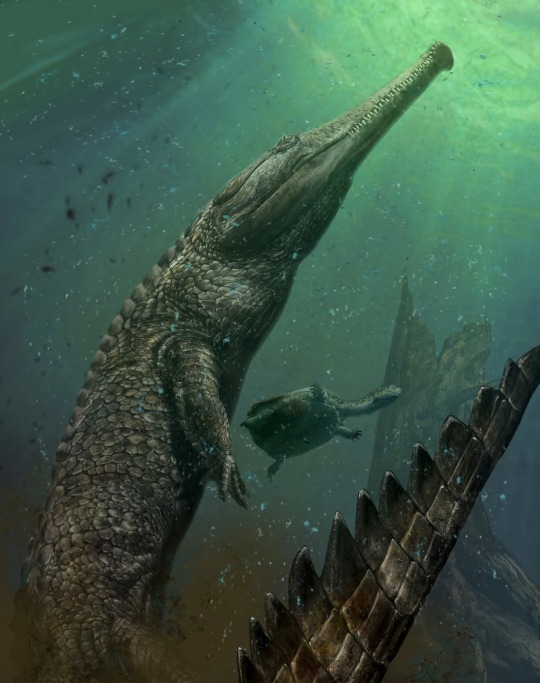
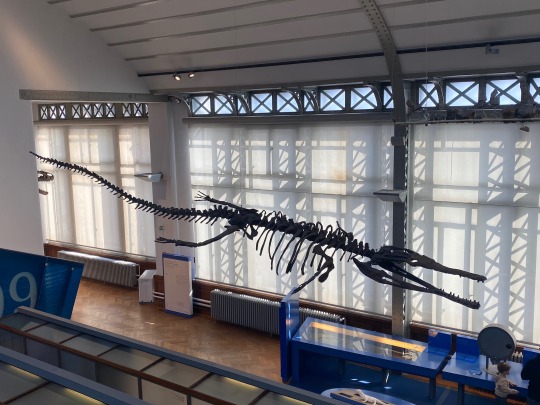
This is Machimosaurus, an impressive crocdile-like Jurassic predator from our Evolution Gallery !
Machimosaurus is a crocodyliform of the Teleosaur family, which ruled the seas and oceans from the Upper Jurassic to the Early Cretaceous.
Members of the Teleosaur family were initially more slender, with a much longer snout efficient at catching smaller preys such as fish. However, over time, Machimosaurus evolved to become particularly larger than its relatives, with a slightly shorter snout.
Semi-aquatic, Machimosaurus was able to venture ashore to hunt. However, this exceptional swimmer was a master of deep-sea hunting. In the water, it used its short legs to steer and to keep balance, while its robust tail allowed Machimosaurus to propel itself.
Other distinguishing features of this species were its massive skull and long snout. Using its conical, rounded teeth and an overpowering jaw force, Machimosaurus was able to target larger or shelled prey: fish, turtles and other marine reptiles, as well as some overly adventurous terrestrial species had to be especially cautious of this fierce predator.
Fossils of this 100-million-year-old giant have been discovered in several countries across Europe and Africa. These findings have allowed palaeontologists to separate, to this date, the lineage of Machimosaurus into five probable species.
One of these, the Machimosaurus rex recovered from a desert in Tunisia in 2016, could be the largest member of this lineage. According to various estimates, this animal could have grown up to more than 7 metres in length, for 3 tonnes: not the kind you'd want to meet in a face-off!
[Picture by visitor Merle Van Faassen, and Machimosaurus Rex illustration by Davide Bonadonna]
#naturalscience#naturalsciences#natural history#natural history museum#machimosaurus#jurassic#cretaceous#museumvisitor#naturalsciencesbrussels#royal belgian institute of natural sciences
50 notes
·
View notes
Text
youtube
Spanish archaeologists made an unusual discovery in southern Egypt: a still undisturbed tomb containing ten mummified crocodiles. Archaeologists from the Royal Belgian Institute of Natural Sciences were able to study the mummies. ‘An extraordinary find’, says archeozoologist Bea De Cupere (RBINS). Ancient Egyptians sacrificed crocodiles during rituals to their god Sobek.
News article on our website
In 2019, archaeologists from the University of Jaén uncovered a tomb containing crocodile mummies in Qubbat al-Hawā, a site near the city of Aswan in southern Egypt. The small rock cut tomb contained five skeletons and five skulls of large crocodiles. It lies next to six other tombs in which dignitaries of the region were buried. They all date from the pre-ptolemaic era, before 304 BC.
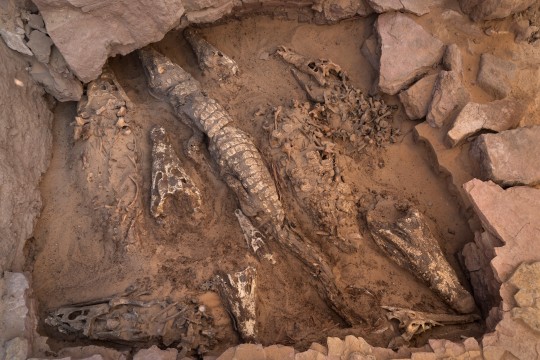
The crocodiles may have been used during rituals for the Egyptian god Sobek, the god of water and fertility, often depicted with a crocodile head. Kom Ombo, just 50 kilometres away, was an important centre for crocodile worship.
'More than 20 burial sites with crocodile mummies are known in Egypt, but to find 10 well-preserved crocodile mummies together in an undisturbed tomb is extraordinary,' says Bea De Cupere. 'Of most mummies collected by museums in the late 19th and early 20th centuries, often hatchlings, we don't know exactly where they come from.'
The archaeologists at Qubbat al-Hawā found traces of linen, palm leaves and rope, associated with some of the crocodiles, indicating that they had once been wrapped. However, the linen bandages must have rotted away, and the crocodiles weren’t covered with large amounts of pitch or bitumen, which was common in more recent periods. A happy coincidence, as this allowed the researchers to measure and study these specimens thoroughly.

Natural mummification
The smallest crocodile is 1.8 metres long, the largest 3.5 metres. They belong to two different species: the Nile crocodile and the West African crocodile. Remarkably, three skeletons were almost complete, with the other two missing quite a few parts. 'The crocodiles were first buried elsewhere, possibly in sand pits,' says De Cupere. 'This allowed the crocodiles to dry out naturally. Then the remains were unearthed, wrapped and moved to the tomb in Qubbat al-Hawā. Body parts must have been lost during wrapping and transport.'
How did the Egyptians catch these crocodiles? We know from iconography that crocodiles were caught mainly with nets. No slaughter marks have been found on the crocodiles from Qubbat al-Hawā. Possibly the crocodiles were drowned, suffocated or overheated by exposing them to the sun for long periods of time.
Stones in stomach
One crocodile was so well preserved that the gastroliths were still present. These are stones in the intestines that help crocodiles stay balanced in the water. The stones indicate that the crocodile was not cut open to take out the intestines.
‘I'm thrilled that finds like these give us another glimpse into the life of ancient Egyptians’, says De Cupere. The study appeared in the scientific journal PLOS ONE.
#discovery#crocodiles#mummies#ancient egypt#egypt#ritual#archaeology#archaeozoology#royal belgian institute of natural sciences#naturalsciencesbrussels#science news#video#Youtube
29 notes
·
View notes
Text
youtube
How can you keep track in a Mikado of dinosaur fossils? Our last vlog from Wyoming (it's a wrap! 🎬), with archaeologist and drone pilot Aurore Mathys.
[video: Reinout Verbeke (@deachterkant); drone and 3D footage: Stijn Pardon and Aurore Mathys, @rbins]
Watch the other five vlogs we made.
Read the full story.
#diggingjurassicdinosaurs#naturalsciencesbrussels#royal belgian institute of natural sciences#fossils#dinosaurs#dinosaur#excavations#fieldwork#wyoming#natural sciences#natural history#drone#droneporn#droning#dronephotography#photogrammetry#camarasaurus#palaeontology#Youtube
9 notes
·
View notes
Text
youtube
The excavation summer of the Royal Belgian Institute of Natural Sciences (@rbins) in Wyoming is coming to an end. One hell of a piece to extract is the pelvis of Morris, the young camarasaurid dinosaur.
Paleo engineer Xavier Valentin (University of Poitiers) explains. (Subtitles in English, French or Dutch)
[video: Thierry Hubin, Reinout Verbeke (@deachterkant) ; drone footage: Aurore Mathys]
Watch the five other vlogs we made.
#diggingjurassicdinosaurs#naturalsciencesbrussels#rbinsfieldwork#fieldwork#wyoming#dinosaurs#dinosaur#fossils#sauropod#camarasaurus#Youtube#royal belgian institute of natural sciences
4 notes
·
View notes
Text
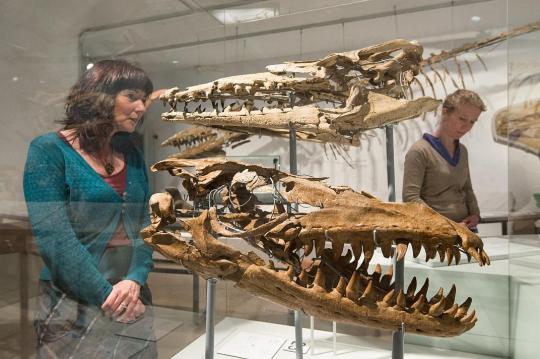
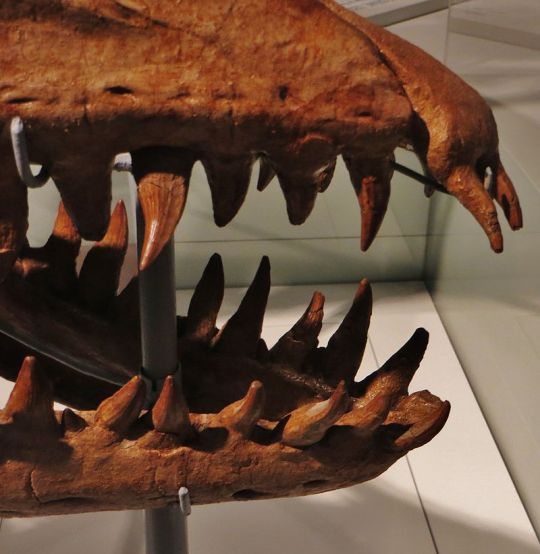
📷 Not a T. rex but a Sea rex! This is the skull of Prognathodon solvayi.
Flashback to the end of the Cretaceous, some 70 million years ago: when tyrannosaurs ruled the continents, gigantic predatory lizards dominated the warm seas. Prognathodon was one of them. This animal belonged to the mosasaur family.
This nice specimen is very Belgian: it was excavated in 1889 in Ciply near Mons (Hainaut) and described that same year by Belgian paleontologist Louis Dollo (who also studied our Bernissart Iguanodons!). As you can see the skull is very robust, with a long, flexible jaw and sharp teeth. Prognathodon surely had a powerful bite! Turtles, sharks, ammonites, … they all went down its throat!
Prognathodon solvayi was relatively small, barely reaching 5 meters in length, while other species potentially reached 10 metres and more. Mosasaurs in general had long hydrodynamic bodies, flippers for balance and a powerful tail for propulsion (an upside-down shark’s tail, with the fleshy upper lobe smaller than the lower). They were one of the greatest success stories of their time, and it took the mass extinction at the end of the Cretaceous – some 66 million years ago – to wipe them out completely.
This specimen is on display in our Mosasaur Hall. Another Belgian must-see is the near-complete 12.5-metre-long mosasaur skeleton (Hainosaurus bernardi) hanging from the ceiling.
110 notes
·
View notes
Text


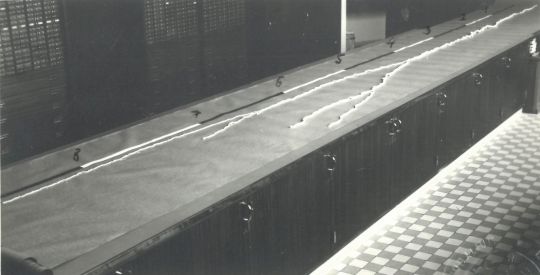
3D printed by nature: fulgurite! When a quartz-rich soil - like sand for example - gets struck by lightning, the quartz grains get so hot that they fuse together, forming a sort of hollow, glassy tube: a fulgurite or “fossilized lightning”.
Fulgurites can be found several meters below the surface. They must be excavated with great care, because they are very fragile.
We keep some of these “vitrified lightnings” in our collection, one of which is 8,4 (!) meters long and was dug up in 1955 in Zutendaal, Limburg (Belgium). What a stunner!
#nature is the greatest show#naturalsciencesbrussels#royal belgian institute of natural sciences#collections#geology
75 notes
·
View notes
Text
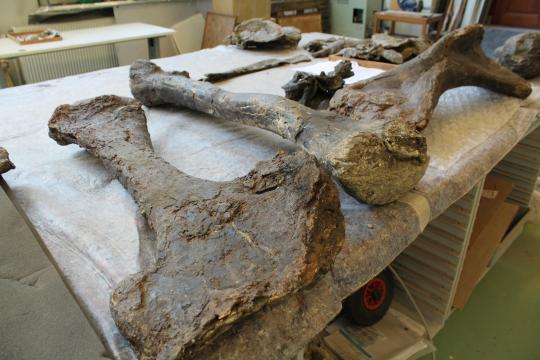


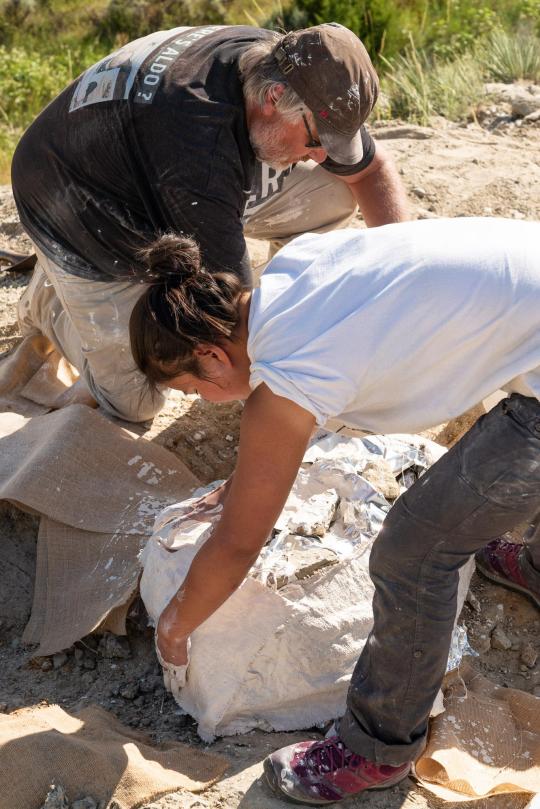

‘Big’ news! A fantastic acquisition for our collections: a nearly-complete skeleton of a long-necked dinosaur of about 20 metres in length. “Dan”, as we named him, may well belong to a new species of diplodocus-like dinosaurs.
Dan originates from Kaycee, Wyoming, where we participated in excavations in the last few years. This well-preserved specimen is 155 million years old (that's the Upper Jurassic). Allosaurus Arkhane, exhibited at @rbins, was excavated at the same site, about 250 metres from Dan.
The preparation of the skeleton has started and will reveal many secrets in the next two years. And then Dan will become one of the many stars of our Dinosaur Gallery!
#Diplo Dan#naturalsciencesbrussels#dinosaurs#sauropods#fossils#fossil friday#palaeontology#excavations#collections#royal belgian institute of natural sciences
60 notes
·
View notes
Text



Immediately after the extinction of the dinosaurs ☄️, it was more beneficial for mammals to be big 💪 than to be smart, concludes a new study we collaborated on.
It was not until ten million years after the dinosaur era that early representatives of modern mammal groups, such as primates, began to develop larger brains 🧠 and a more complex range of sensory and motor skills. This would have improved their chances of survival at a time when competition for resources had become much greater.
Read the complete article on our website
[picture 1: a skull from our collections was one of the key fossils for this study in Science. Photo: Thierry Smith]
[picture 2: left is a reconstruction of the Eocene mammal Hyrachyus modestus, a rhinoceros-tapir ancesto, with already bigger brains; right is the small-brained Paleocene mammal Arctocyon primaevus, a carnivorous predator most closely related to the group including living pigs and sheep. Image: Sarah Shelley]
[picture 3: Crania and virtual endocasts of the Paleocene mammal Arctocyon primaevus (left, with smaller brain) and of the Eocene mammal Hyrachyus modestus (right, with bigger brain). Images: Ornella Bertrand and Sarah Shelley]
#sciencenews#natural sciences#mammals#mammal evolution#fossils#fossil friday#palaeontology#collections#naturalsciencesbrussels#royal belgian institute of natural sciences
50 notes
·
View notes
Text
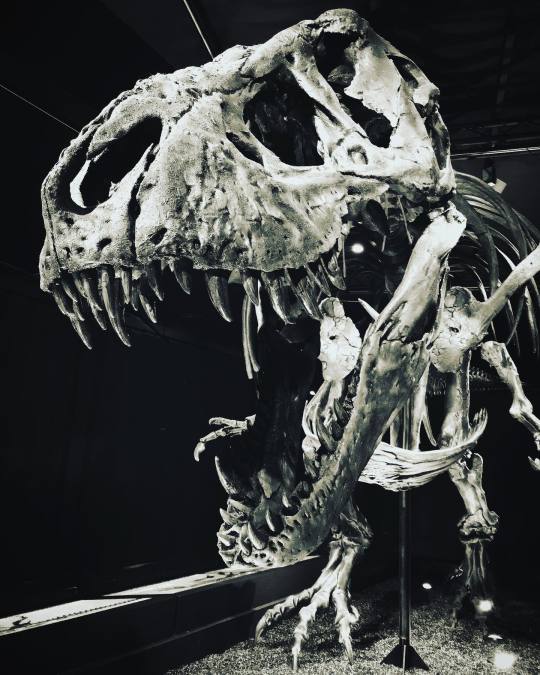

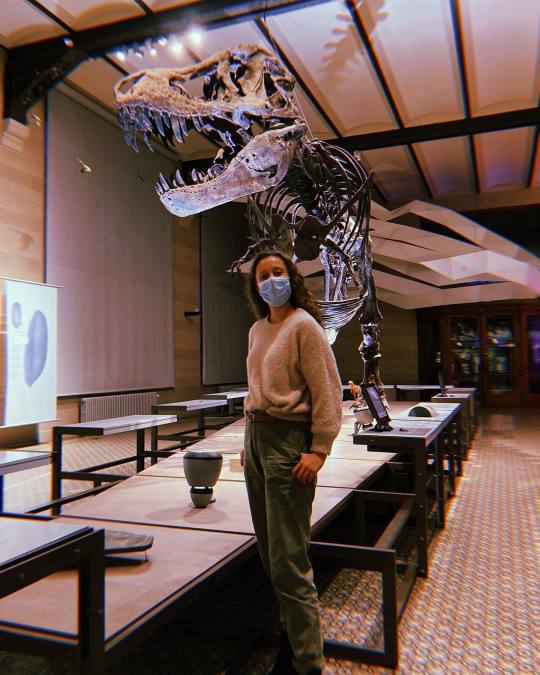

📷 Trix vs Stan! Come and admire the two T. rexes currently exhibited @rbins. 🦖 🦖
In the first two pictures is the 3D-printed version of Trix, the specimen of our Dutch friends of Naturalis in Leiden. In the last two pics you see our cast of Stan.
Both of them:
- were top predators during the very last part of the Upper Cretaceous period, the last chapter in the book of dinosaurs (avian dinosaurs as current birds have written a nice sequel! 😊)
- were excavated in the Hell Creek Formation of North America: Trix near Jordan in Montana 📍, Stan near Buffalo in South Dakota 📍 (a 4 hour drive from each other).
- were prepared by the Black Hills Institute in Hill City, South Dakota
- are among the most complete 🧩 of some thirty T. rex specimens known today
- have healed bite marks and wounds 🩸 probably caused by other T. rexes
- had 50 to 60 teeth, some as big as bananas 🍌. They are robust and serrated allowing T. rex to bite through flesh and bone. The teeth were replaced throughout their lives.
- had well-developed senses: 👃 olfactory lobes almost as large as their brain, a highly developed inner ear 👂 that could perceive low frequency sounds, and small eyes 👁️ located towards the front of the skull (like we have) which demonstrates stereoscopic, 3D vision.
They also differ:
- Trix is seen as a female, Stan as a male, although palaeontologists are still debating…
- Trix is a bit longer and higher than Stan 📏: 12.5 m vs 11.7 m; 4 m vs 3.64 m
- Both were old when they died, but Trix is the oldest T. rex so far: more than 30 years of age
- Trix is estimated to be at least 67 million years old, Stan 66 million.
- Stan was named after its finder: amateur palaeontologist Stan Sacrison, who discovered the first of Stan's bone fragments. Trix is both an allusion to "T-rex" and to former Queen Beatrix of the Netherlands: so Trix is the Queen of the Cretaceous! 👑
- Stan has had more admirers so far as he is all over the world: it’s the most duplicated T. rex fossil.
- Trix is publicly available for research, Stan for the moment is not. The original specimen was auctioned and sold for 💲31.8 million dollars to an anonymous private buyer in 2020, making it the most expensive fossil ever sold. Its future as a study object and museum exhibit is uncertain at this moment.
[Pictures of Trix on Instagram by visitors @pavel_sb and @mrdieds ; of Stan by @elisebormans and @ omar_cirilli]
#expotrexbrussels#naturalsciencesbrussels#naturalsciences#trex#tyrannosaurus rex#palaeontology#fossil friday#dinosaurs
66 notes
·
View notes